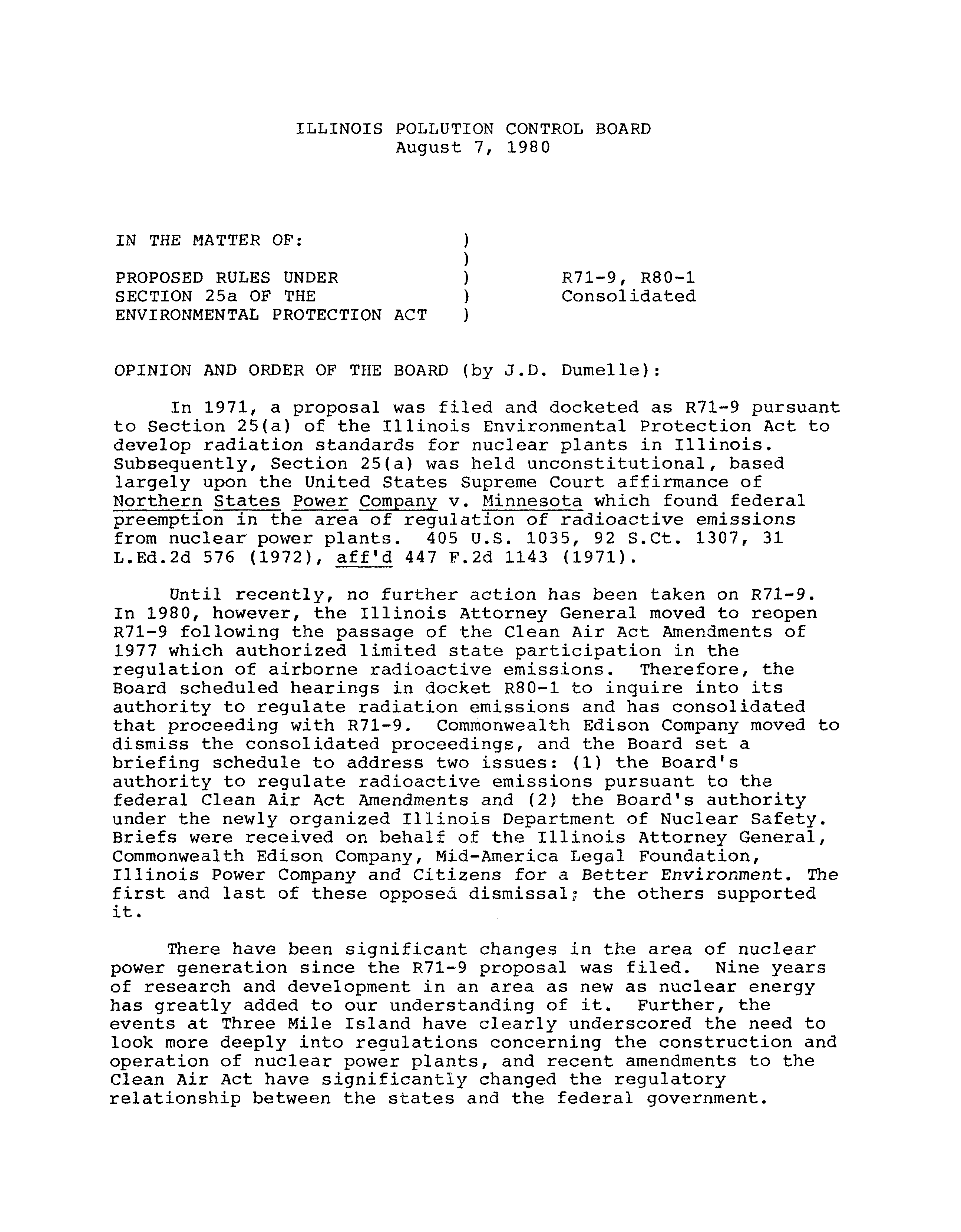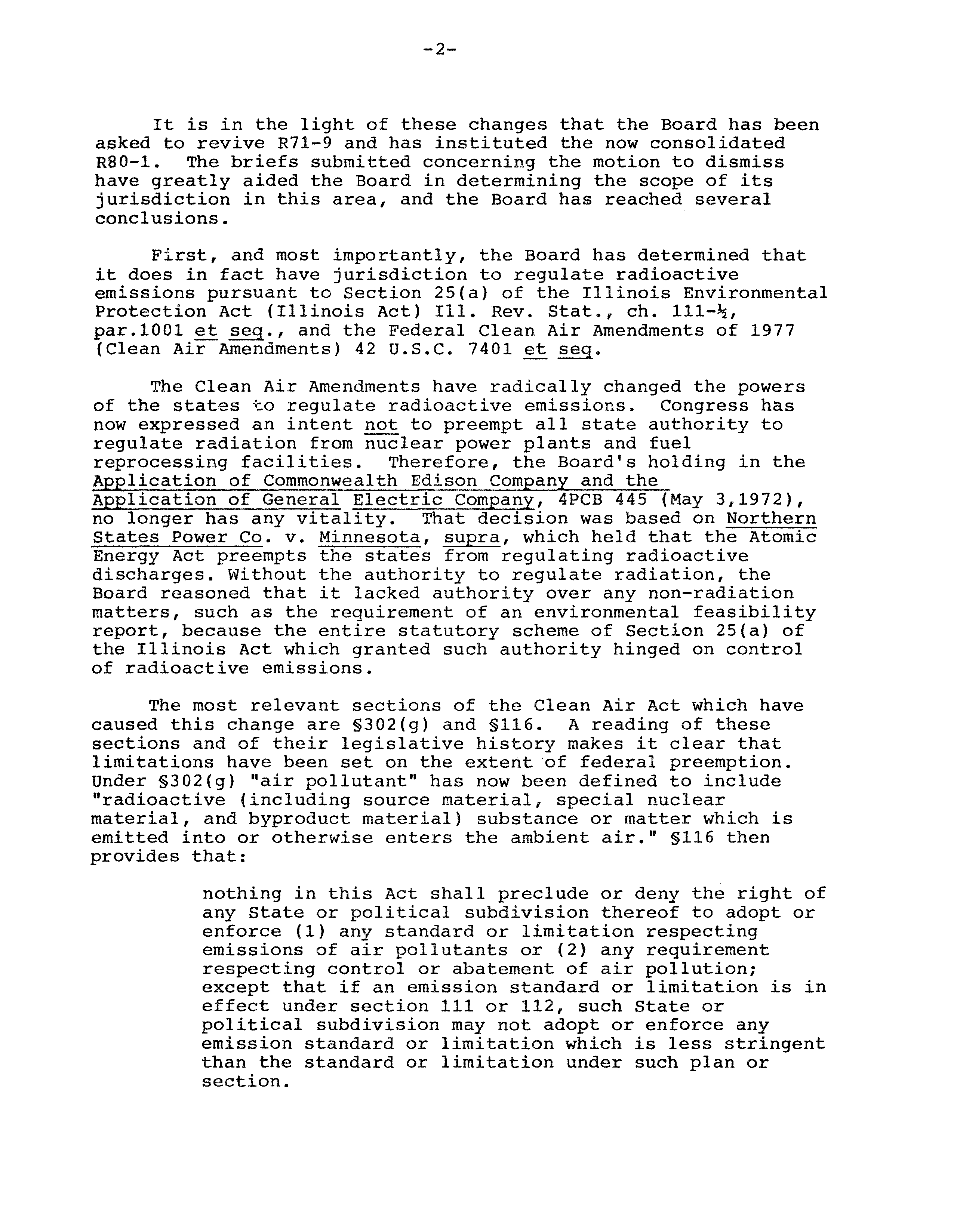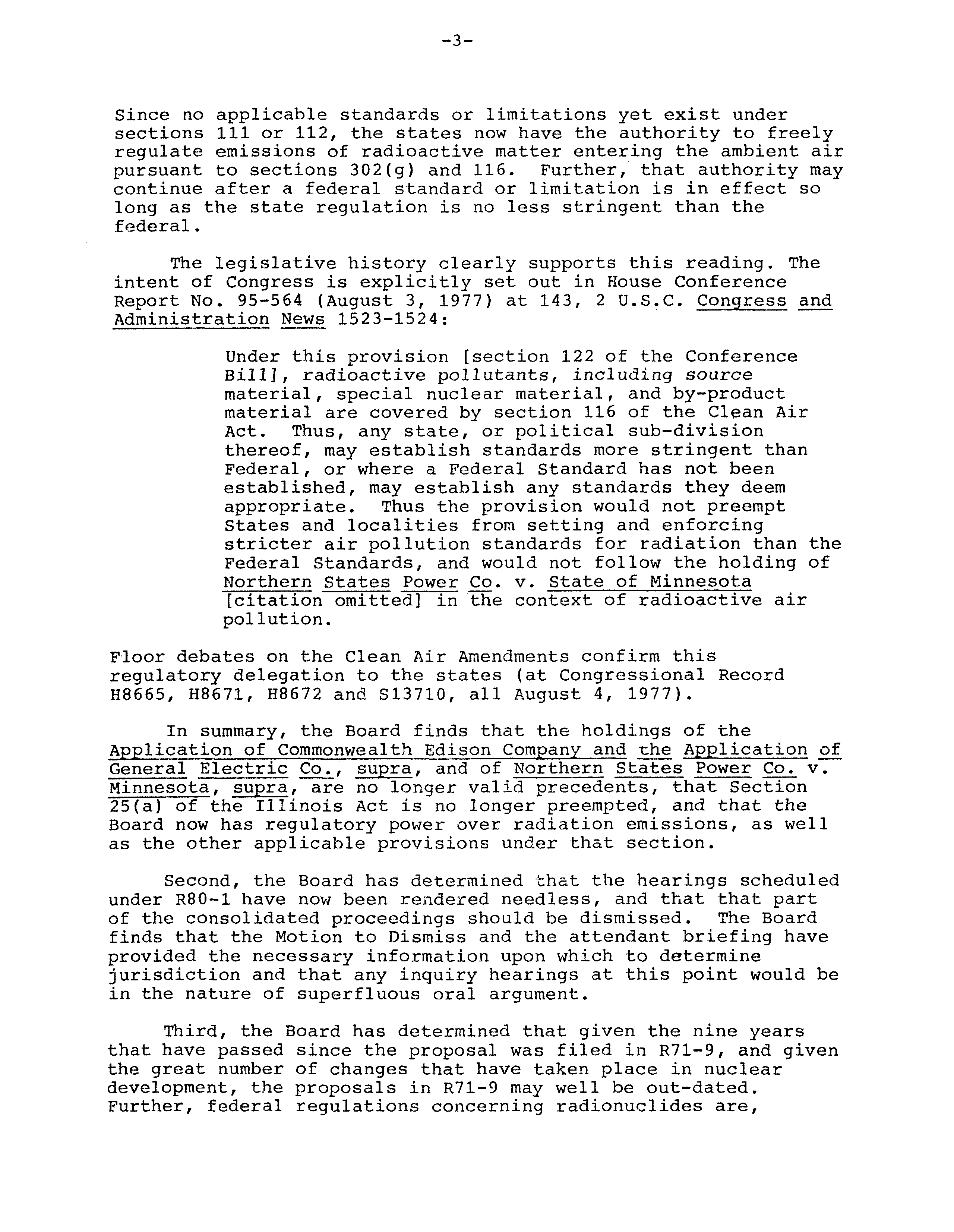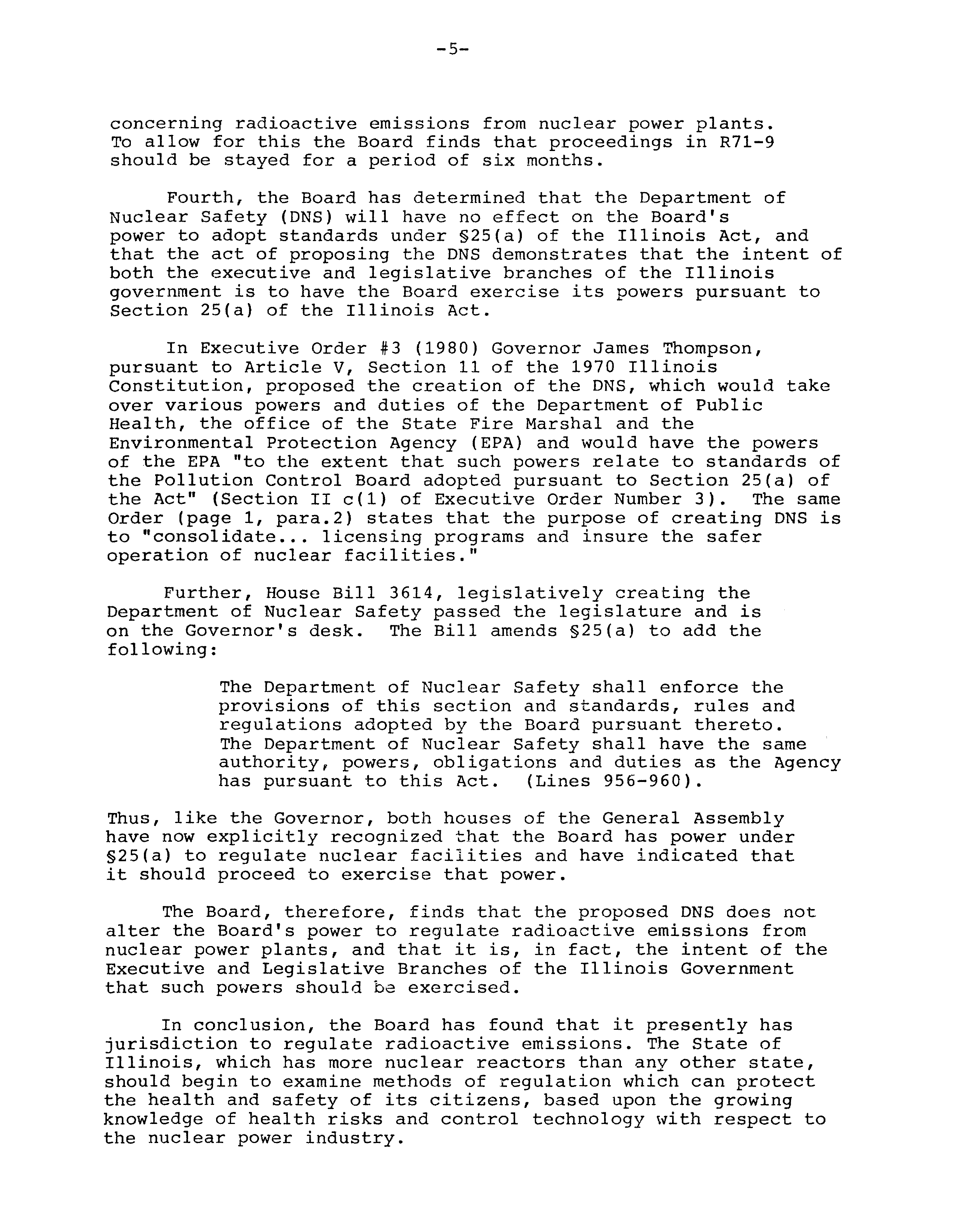ILLINOIS POLLUTION CONTROL BOARD
August
7,
1980
IN THE MATTER OF:
)
PROPOSED RULES UNDER
)
R71—9,
R80—1
SECTION 25a OF THE
)
Consolidated
ENVIRONMENTAL PROTECTION ACT
OPINION AND ORDER OF THE BOARD
(by J.D. Dumelle):
In 1971,
a proposal was filed and docketed as R71—9 pursuant
to Section 25(a) of the Illinois Environmental Protection Act to
develop radiation standards for nuclear plants in Illinois.
Subsequently, Section 25(a) was held unconstitutional, based
largely upon the United States Supreme Court affirmance of
Northern States Power Company v. Minnesota which found federal
preemption
in the area of regulation of radioactive emissions
from nuclear power plants.
405 U.S.
1035,
92 S.Ct.
1307,
31
L.Ed.2d 576
(1972), aff’d 447 F.2d 1143
(1971).
Until
recently, no further action has been taken on R71—9.
In
1980, however, the Illinois Attorney General moved to reopen
R71—9 following the passage of the Clean Air Act Amendments of
1977 which authorized limited state participation in the
regulation of airborne radioactive emissions.
Therefore, the
Board scheduled hearings in docket
P.80—i to inquire into its
authority to regulate radiation emissions and has consolidated
that proceeding with R71-9.
Commonwealth Edison Company moved to
dismiss the consolidated proceedings, and the Board set a
briefing schedule to address two issues:
(1)
the Board’s
authority to regulate radioactive emissions pursuant to the
federal Clean Air Act Amendments and
(2)
the Board’s authority
under the newly organized Illinois Department of Nuclear Safety.
Briefs were received on behalf of the Illinois Attorney General,
Commonwealth Edison Company, Mid-America Legal Foundation,
Illinois Power Company and Citizens for a Better Environment. The
first and last of these opposed dismissal;
the others supported
it.
There have been significant changes in the area of nuclear
power generation since the R71—9 proposal was
filed.
Nine years
of research and development in an area as new as nuclear energy
has greatly added to our understanding of it.
Further,
the
events at Three Mile Island have clearly underscored the need to
look more deeply into regulations concerning the construction and
operation of nuclear power plants, and recent amendments to the
Clean Air Act have significantly changed the regulatory
relationship between the states and the federal government.
—2—
It is in the light of these changes that the Board has been
asked to revive R71-9 and has instituted the now consolidated
P.80-i.
The briefs submitted concerning the motion to dismiss
have greatly aided the Board in determining the scope of its
jurisdiction in this area, and the Board has reached several
conclusions.
First, and most importantly, the Board has determined that
it does
in fact have jurisdiction to regulate radioactive
emissions pursuant to Section 25(a) of the Illinois Environmental
Protection Act
(Illinois Act)
Ill. Rev.
Stat.,
oh.
111—½,
par.100i et
~
and the Federal Clean Air Amendments of 1977
(Clean Air Amendments)
42 U.S.C.
7401 et
~.
The Clean Air Amendments have radically changed the powers
of the states to regulate radioactive emissions.
Congress has
now expressed an intent not to preempt all state authority to
regulate radiation from nuclear power plants and fuel
reprocessing facilities.
Therefore,
the Board’s holding in the
Application of Commonwealth Edison Company and the
Application of General Electric Company,
4PCB 445
(May 3,1972),
no longer has any vitality.
That decision was based on Northern
States Power Co.
v. Minnesota,
supra, which held that the Atomic
Energy Act preempts the states from regulating radioactive
discharges.
Without the authority to regulate radiation, the
Board reasoned that it lacked authority over any non—radiation
matters,
such as the requirement of an environmental feasibility
report, because the entire statutory scheme of Section 25(a) of
the Illinois Act which granted such authority hinged on control
of radioactive emissions.
The most relevant sections of the Clean Air Act which have
caused this change are §302(g) and §116.
A reading of these
sections and of their legislative history makes
it clear that
limitations have been set on the extent ‘of federal preemption.
Under §302(g)
“air pollutant” has now been defined to include
“radioactive (including source material, special nuclear
material, and byproduct material)
substance or matter which is
emitted into or otherwise enters the ambient air.” §116 then
provides that:
nothing in this Act shall preclude or deny the right of
any State or political subdivision thereof to adopt or
enforce
(1)
any standard or limitation respecting
emissions of air pollutants or
(2
any requirement
respecting control or abatement of air pollution;
except that if an emission standard or limitation is in
effect under section 111 or 112, such State or
political subdivision may not adopt or enforce any
emission standard or limitation which is less stringent
than the standard or limitation under such plan or
section.
—3—
Since
no applicable standards or limitations yet exist under
sections
lii or 112, the states now have the authority to freely
regulate emissions of radioactive matter entering the ambient air
pursuant to sections 302(g) and 116.
Further, that authority may
continue after a federal standard or limitation is in effect so
long as the state regulation is no less stringent than the
federal.
The legislative history clearly supports this reading.
The
intent of Congress is explicitly set out
in House Conference
Report No.
95—564
(August
3,
1977)
at 143,
2 U.S.C.
Congress and
Administration News 1523-1524:
Under this provision section
122 of the Conference
BillJ,
radioactive pollutants,
including
source
material, special nuclear material,
and by—product
material
are covered by section 116 of the Clean Air
Act.
Thus,
any state, or political sub—division
thereof, may establish standards more stringent than
Federal, or where a Federal Standard has not been
established, may establish any standards they deem
appropriate.
Thus the provision would not preempt
States and localities from setting and enforcing
stricter air pollution standards for radiation than the
Federal Standards,
and would not follow the holding of
Northern States Power Co.
v. State of Minnesota
citation
omitted
in the context of radioactive air
pollution.
Floor debates on the Clean Air Amendments confirm this
regulatory delegation to the states
(at Congressional Record
H8665,
H8671,
H8672 and S13710,
all August
4,
1977).
In summary, the Board finds that the holdings of the
Application of Commonwealth Edison Company and the Application of
General Electric Co.,
supra,
and of Northern States Power Co.
v.
Minnesota, supra,
are no longer valid precedents,
that Section
25(a) of the Illinois Act
is no longer preempted,
and that the
Board now has regulatory power over radiation emissions,
as well
as the other applicable provisions under that section.
Second, the Board has determined that the hearings scheduled
under R80—1 have now been rendered needless, and that that part
of the consolidated proceedings should he dismissed.
The Board
finds that the Motion to Dismiss and the attendant briefing have
provided the necessary information upon which to determine
jurisdiction and that any inquiry hearings at this point would be
in the nature of superfluous oral argument.
Third, the Board has determined that given the nine years
that have passed since the proposal was filed in R71—9, and given
the great number of changes that have taken place in nuclear
development,
the proposals in R71-9 may well be out-dated.
Further,
federal regulations concerning radionuclides are,
—4—
apparently,
in the process of being developed, and the
promulgation of such regulations will change the context of the
state/federal regulatory scheme.
Pursuant to Section 122(a) of the Clean Air Act, the
Administrator of the U.S.
Environmental Protection Agency has
added radionuclides to the list of hazardous air pollutants in
accordance with Section 112(b)(1)(A) of that act
(44 Fed.
Reg.
76738
(December 27,
1979)) and under Section 112(b)(i)(B) has 180
days to publish a proposed emission standard or not to promulgate
a standard if he finds the pollutant is clearly not hazardous.
That last step has not as yet taken place, and, therefore,
there
are presently ~o limitations on the state authority to regulate
radionuclides.
However, once federal standards are set, §112(d)(1)
of the
Clean Air Act provides:
Each State may develop and submit to the Administrator
a procedure for implementing and enforcing emission
standards for hazardous air pollutants for stationary
sources located in such State.
If the Administrator
finds the State procedure is adequate, he shall
delegate to such State any authority he has under this
Act to implement and enforce such standards.
This section in conjunction with Section 9.1 of the Illinois
Act which provides that the “Board shall adopt rules which are in
substance identical with federal regulations promulgated...
to
implement Sections...112,” may limit the power of the Board to
regulate radioactive emissions once federal standards are set.
However,
the Board
is not at this time finding that §112(d)(1) of
the Clean Air Act and §9.1 of the Illinois ~tctwill foreclose the
possibility of independent State regulation.
As of now neither
section has been triggered by the setting of federal standards.
Therefore,
the Board finds that
P.71—9 should not be
dismissed but that further proceedings are not presently
appropriate.
Time
is needed for the Department of Nuclear
Safety or any other interested proponent to develop and propose
a regulatory scheme reflecting the present state of knowledge
‘Those briefs favoring dismissal of these proceedings have
indicated that,
under section 112(d) (1) of the Clean Air Act,the
stat&s participation in regulation of radioactive discharges is
limited to developing enforcement procedures only after a federal
emission standard has been established for a hazardous air
pollutant under section 112(b)(1)(B).
However, having found that
the states now have the authority to set independent standards
under Section 116,
the Board finds that it could not have been
the intent of Congress to set up a gap in the regulatory scheme
whereby standards which are promulgated by the states pursuant to
Section 116 are suspended pursuant to Section 112 when the USEPA
lists a hazardous air pollutant, but before any federal standards
are promulgated, only to later have USEPA standards control.
—5—
concerning radioactive emissions from nuclear power plants.
To allow for this the Board finds that proceedings in R71—9
should be stayed for a period of six months.
Fourth, the Board has determined that the Department of
Nuclear Safety
(DNS) will have no effect on the Board’s
power to adopt standards under §25(a) of the Illinois Act, and
that the act of proposing the DNS demonstrates that the intent of
both the executive and legislative branches of the Illinois
government is to have the Board exercise its powers pursuant to
Section 25(a) of the Illinois Act.
In Executive Order #3
(1980)
Governor James Thompson,
pursuant to Article V,
Section 11 of the 1970 Illinois
Constitution, proposed the creation of the DNS, which would take
over various powers and duties of the Department of Public
Health, the office of the State Fire Marshal and the
Environmental Protection Agency
(EPA)
and would have the powers
of the EPA “to the extent that such powers relate to standards of
the Pollution Control Board adopted pursuant to Section 25(a)
of
the Act”
(Section II c(1) of Executive Order Number 3).
The same
Order
(page
1,
para.2)
states that the purpose of creating DNS is
to “consolidate..,
licensing programs and insure the safer
operation of nuclear facilities.”
Further, House Bill 3614,
legislatively creating the
Department of Nuclear Safety passed the legislature and is
on the Governor’s desk.
The Bill amends §25(a) to add the
following:
The Department of Nuclear Safety shall enforce the
provisions of this section and standards,
rules and
regulations adopted by the Board pursuant thereto.
The Department of Nuclear Safety shall have the same
authority, powers, obligations and duties as the Agency
has pursuant to this Act.
(Lines 956—960).
Thus,
like the Governor, both houses of the General Assembly
have now explicitly recognized that the Board has power under
§25(a) to regulate nuclear facilities and have indicated that
it should proceed to exercise that power.
The Board,
therefore,
finds that the proposed DNS does not
alter the Board’s power to regulate radioactive emissions from
nuclear power plants, and that it is,
in fact, the intent of the
Executive and Legislative Branches of the Illinois Government
that such powers should be exercised.
In conclusion,
the Board has found that
it presently has
jurisdiction to regulate radioactive emissions.
The State of
Illinois, which has more nuclear reactors than any other state,
should begin to examine methods of regulation which can protect
the health and safety of its citizens, based upon the growing
knowledge of health risks and control technology with respect to
the nuclear power industry.
—6—
This opinion constitutes the Board’s finding of facts and
conclusions of law in this matter.
ORDER
1.
Hearings set under R80—1 are hereby vacated,
and
that part of the consolidated proceedings of P.71—9
and P.80—i is dismissed.
2,
Proceedings
in R71—9 are hereby stayed for
a period of
6 months from the date of this
order,
that being February
9,
1981.
IT IS SO ORDERED.
I, Christan L. Moffett,
Clerk of the Illinois Pollution
Control B~ard,hereby certi y that the above Orde~wasadopted
on the ~
day of
_______
1980 by a vote of
~.O
Christan L. Mo ~
Clerk
Illinois Pollution control Board






